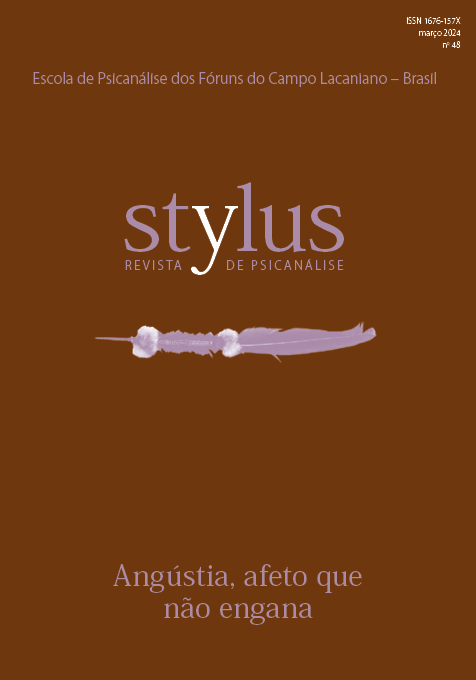Void of void
anguish, median void in Chinese thought, and poetic function of the word
DOI:
https://doi.org/10.31683/stylus.v1i48.1114Keywords:
Object of anguish, Chinese thought, psychoanalytic act, Lacanian topology, LanguageAbstract
Lacan worked on Chinese texts to evoke the action of the analyst, and through these texts, he intended to grasp what absence was, expressed as the median void, characterized by Chinese thought. The theoretical development on the object of anxiety was the theoretical guide for the articulation between Lacanian thought and Chinese thought. As a conclusion, we reached a new function of the word and its implications in the field of experience, focusing on Lacan’s interest in the “median void.”
Downloads
References
Bousseyroux, M. (2011). Faire plus que parler. L’en-Je Lacanien, 16(1), 27. Recuperado de https://doi.org/10.3917/enje.016.0027
Bousseyroux, M. (2015). Le vase de Werner Boy et le dahlia noir de l’angoisse. L’en-Je Lacanien, 25(2), 9-24. Recuperado de https://doi.org/10.3917/enje.025.0009
Castanet, D. (2020). De l’angoisse à l’objet a. L’en-Je Lacanien, 34(1), 5-7. Recuperado de https://doi.org/10.3917/enje.034.0005
Cheng, F. (2016). Lacan e o pensamento chinês. In F. Cheng. Lacan, o escrito, a imagem (Y. Vilela, Trad.) (1a ed., 1a reimpr.). Belo Horizonte: Autêntica. (Filô/Margens, 2)
Duyvendak, J. J. L., Houang, F., & Leiris, P. (1979). Livre de la voie et de sa vertu. Paris: Points/Seuil.
Lacan, J. (1959). Le désir. Version Staferla. Recuperado de http://staferla.free.fr/S6/S6%20LE%20DESIR.pdf
Lacan, J. (1969). Séminaire 17 : L’envers de la psychanalyse. Version Staferla. Recuperado de http://staferla.free.fr/S17/S17.htm
Lacan, J. (1971). Séminaire 19 : ou pire. Version Staferla. Recuperado de http://staferla.free.fr/S19/S19...OU%20PIRE.pdf
Lacan, J. (1974). Séminaire 22 : R.S.I. Version Staferla. Recuperado de http://staferla.free.fr/S22/S22%20R.S.I..pdf
Lacan, J. (1976). Séminaire 24 : l’insu… Version Staferla. Recuperado de http://staferla.free.fr/S24/S24%20L’INSU....pdf
Lacan, J. (1977a). Séminaire 24 : l’ insu que sait d’ une bévue s’ aile a mourre. Version Staferla. Recuperado de http://staferla.free.fr/S24/S24%20L’INSU....pdf
Lacan, J. (1977b). Séminaire 25 : le moment de conclure. Version Staferla. Recuperado de http://staferla.free.fr/S25/S25.pdf
Lacan, J. (2003a). Função e campo da linguagem em psicanálise. In J. Lacan. Escritos. Rio de Janeiro: Jorge Zahar Editora.
Lacan, J. (2003b). Resposta ao comentário de Jean Hyppolite sobre a Verneinung de Freud. In J. Lacan. Escritos. Rio de Janeiro: Jorge Zahar Editor.
Lacan, J. (2003c). O aturdito. In J. Lacan. Outros escritos. Rio de Janeiro: Jorge Zahar Editora.
Pizarnik, A. (2014). Fragmentos para dominar o silêncio (D. Pessoa & V. N. Honesko). Revista Polichinello, Belém: Lume, (16).
Seraphin, C. (s/d). Entretiens de Confucius, Mencius, Le milieu juste. China: Kuang-Chi.
Soury, P. (1986). Chaines et noeuds troisième partie. Editado por Michel Thomé e Christian Léger.
Downloads
Published
How to Cite
Issue
Section
License
Ao encaminhar os originais, os autores cedem os direitos de publicação para STYLUS.
Os autores assumem toda responsabilidade sobre o conteúdo do trabalho, incluindo as devidas e necessárias autorizações para divulgação de dados coletados e resultados obtidos, isentando a Revista de toda e qualquer responsabilidade neste sentido.



